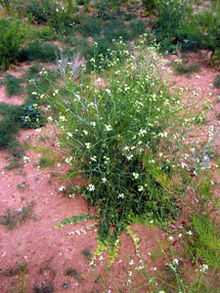Sisymbrium altissimum
From Wikipedia, the free encyclopedia
| Sisymbrium altissimum | |
|---|---|
 | |
| Scientific classification | |
| Kingdom: | Plantae |
| (unranked): | Angiosperms |
| (unranked): | Eudicots |
| (unranked): | Rosids |
| Order: | Brassicales |
| Family: | Brassicaceae |
| Genus: | Sisymbrium |
| Species: | S. altissimum |
| Binomial name | |
| Sisymbrium altissimum L. | |
Sisymbrium altissimum is a species of Sisymbrium. The plant is native to the western part of the Mediterranean Basin in Europe and Northern Africa and is widely naturalized throughout most of the world, including all of North America.[1] It was probably introduced into North America by a contaminant crop seed. The plant grows in soils of all textures, even sand. The plant germinates in winter or early spring. The blooming time is lengthy, and after maturity the plant forms a tumbleweed. Common names of the plant include Jim Hill mustard, after James J. Hill, a Canadian-American railroad magnate,[2] Tall mustard, Tumble mustard,[3] tumbleweed mustard, tall sisymbrium, and tall hedge mustard.[1]
External links
References
- ↑ 1.0 1.1 Royer, France; Richard Dickinson (1999). Weeds of the Northern U.S. and Canada: A Guide for Identification. The University of Alberta Press. p. 470. ISBN 978-1-55105-221-2.
- ↑ Hall, Joan Houston; Cassidy, Frederic G., eds. (1996). Dictionary of American Regional English, Volume III, I-O. Belknap Press. p. 960. ISBN 978-0-674-20519-2.
- ↑ Johnson, Edited by Eileen (1987). Lubbock Lake : late quaternary studies on the southern high plains. College Station: Texas A&M University Press. p. 29. ISBN 0-89096-321-5.
This article is issued from Wikipedia. The text is available under the Creative Commons Attribution/Share Alike; additional terms may apply for the media files.